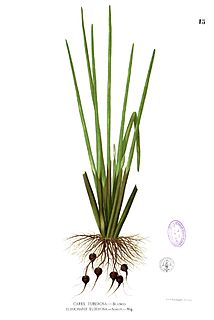
Activated carbon, also called activated charcoal, is a form of carbon commonly used to filter contaminants from water and air, among many other uses. It is processed (activated) to have small, low-volume pores that increase the surface area available for adsorption or chemical reactions. Activation is analogous to making popcorn from dried corn kernels: popcorn is light, fluffy, and has a surface area that is much larger than the kernels. Activated is sometimes replaced by active.

Eleocharis dulcis, the Chinese water chestnut or water chestnut, is a grass-like sedge native to Asia, tropical Africa, and Oceania. It is grown in many countries for its edible corms.

Hydrangea macrophylla is a species of flowering plant in the family Hydrangeaceae, native to Japan. It is a deciduous shrub growing to 2 m (7 ft) tall by 2.5 m (8 ft) broad with large heads of pink or blue flowers in summer and autumn. Common names include bigleaf hydrangea, French hydrangea, lacecap hydrangea, mophead hydrangea, penny mac and hortensia. It is widely cultivated in many parts of the world in many climates. It is not to be confused with H. aspera 'Macrophylla'.

NF-kappa-B essential modulator (NEMO) also known as inhibitor of nuclear factor kappa-B kinase subunit gamma (IKK-γ) is a protein that in humans is encoded by the IKBKG gene. NEMO is a subunit of the IκB kinase complex that activates NF-κB. The human gene for IKBKG is located on chromosome Xq28. Multiple transcript variants encoding different isoforms have been found for this gene.

"In Dulci Jubilo/On Horseback" is a single by musician Mike Oldfield, released in 1975. The festive song features an instrumental version of a Christmas carol, "In dulci jubilo", as well as the final song from Oldfield's Ommadawn album, "On Horseback".

Mitogen-activated protein kinase kinase kinase 7 (MAP3K7), also known as TAK1, is an enzyme that in humans is encoded by the MAP3K7 gene.

Dual specificity mitogen-activated protein kinase kinase 6 also known as MAP kinase kinase 6 or MAPK/ERK kinase 6 is an enzyme that in humans is encoded by the MAP2K6 gene, on chromosome 17.

Cyclic AMP-dependent transcription factor ATF-3 is a protein that, in humans, is encoded by the ATF3 gene.

Cyclic AMP-dependent transcription factor ATF-1 is a protein that in humans is encoded by the ATF1 gene.

Activating transcription factor 6, also known as ATF6, is a protein that, in humans, is encoded by the ATF6 gene and is involved in the unfolded protein response.

Ampelopsin, also known as dihydromyricetin and DHM, when purported as an effective ingredient in supplements and other tonics, is a flavanonol, a type of flavonoid. It is extracted from the Japanese raisin tree and found in Ampelopsis species japonica, megalophylla, and grossedentata; Cercidiphyllum japonicum; Hovenia dulcis; Rhododendron cinnabarinum; some Pinus species; and some Cedrus species, as well as in Salix sachalinensis.

Hydrangenol is a dihydroisocoumarin. It can be found in Hydrangea macrophylla, as well as its 8-O-glucoside. (−)-Hydrangenol 4′-O-glucoside and (+)-hydrangenol 4′-O-glucoside can be found in Hydrangeae Dulcis Folium, the processed leaves of H. macrophylla var. thunbergii.

Phyllodulcin is a dihydroisocoumarin found in Hydrangea macrophylla and Hydrangea serrata. It is a sweetener 400–800 times sweeter than sugar.

Thunberginol A is an isocoumarin found in Hydrangea macrophylla and the herbal preparation hydrangeae dulcis folium which is produced from its leaves.

Thunberginol C is a dihydroisocoumarin found in Hydrangeae Dulcis Folium, the processed leaves of Hydrangea macrophylla var. thunbergii.

Thunberginol D is a dihydroisocoumarin found in Hydrangeae Dulcis Folium, the processed leaves of Hydrangea macrophylla var. thunbergii.

Thunberginol E is a dihydroisocoumarin found in Hydrangeae Dulcis Folium, the processed leaves of Hydrangea macrophylla var. thunbergii.

Thunberginol F is a phthalide found in Hydrangea macrophylla.

Thunberginol G is a dihydroisocoumarin found in Hydrangeae Dulcis Folium, the processed leaves of Hydrangea macrophylla var. thunbergii.


















